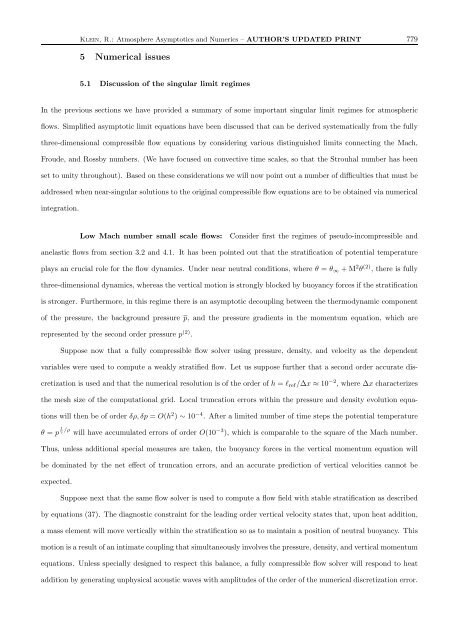Asymptotic Analyses for Atmospheric Flows and ... - FU Berlin, FB MI
Asymptotic Analyses for Atmospheric Flows and ... - FU Berlin, FB MI
Asymptotic Analyses for Atmospheric Flows and ... - FU Berlin, FB MI
You also want an ePaper? Increase the reach of your titles
YUMPU automatically turns print PDFs into web optimized ePapers that Google loves.
Klein, R.: Atmosphere <strong>Asymptotic</strong>s <strong>and</strong> Numerics – AUTHOR’S UPDATED PRINT 779<br />
5 Numerical issues<br />
5.1 Discussion of the singular limit regimes<br />
In the previous sections we have provided a summary of some important singular limit regimes <strong>for</strong> atmospheric<br />
flows. Simplified asymptotic limit equations have been discussed that can be derived systematically from the fully<br />
three-dimensional compressible flow equations by considering various distinguished limits connecting the Mach,<br />
Froude, <strong>and</strong> Rossby numbers. (We have focused on convective time scales, so that the Strouhal number has been<br />
set to unity throughout). Based on these considerations we will now point out a number of difficulties that must be<br />
addressed when near-singular solutions to the original compressible flow equations are to be obtained via numerical<br />
integration.<br />
Low Mach number small scale flows:<br />
Consider first the regimes of pseudo-incompressible <strong>and</strong><br />
anelastic flows from section 3.2 <strong>and</strong> 4.1. It has been pointed out that the stratification of potential temperature<br />
plays an crucial role <strong>for</strong> the flow dynamics. Under near neutral conditions, where θ = θ ∞ +M 2 θ (2) , there is fully<br />
three-dimensional dynamics, whereas the vertical motion is strongly blocked by buoyancy <strong>for</strong>ces if the stratification<br />
is stronger. Furthermore, in this regime there is an asymptotic decoupling between the thermodynamic component<br />
of the pressure, the background pressure p, <strong>and</strong> the pressure gradients in the momentum equation, which are<br />
represented by the second order pressure p (2) .<br />
Suppose now that a fully compressible flow solver using pressure, density, <strong>and</strong> velocity as the dependent<br />
variables were used to compute a weakly stratified flow. Let us suppose further that a second order accurate discretization<br />
is used <strong>and</strong> that the numerical resolution is of the order of h = l ref /∆x ≈ 10 −2 , where ∆x characterizes<br />
the mesh size of the computational grid. Local truncation errors within the pressure <strong>and</strong> density evolution equations<br />
will then be of order δρ, δp = O(h 2 ) ∼ 10 −4 . After a limited number of time steps the potential temperature<br />
θ = p 1 γ /ρ will have accumulated errors of order O(10 −3 ), which is comparable to the square of the Mach number.<br />
Thus, unless additional special measures are taken, the buoyancy <strong>for</strong>ces in the vertical momentum equation will<br />
be dominated by the net effect of truncation errors, <strong>and</strong> an accurate prediction of vertical velocities cannot be<br />
expected.<br />
Suppose next that the same flow solver is used to compute a flow field with stable stratification as described<br />
by equations (37). The diagnostic constraint <strong>for</strong> the leading order vertical velocity states that, upon heat addition,<br />
a mass element will move vertically within the stratification so as to maintain a position of neutral buoyancy. This<br />
motion is a result of an intimate coupling that simultaneously involves the pressure, density, <strong>and</strong> vertical momentum<br />
equations. Unless specially designed to respect this balance, a fully compressible flow solver will respond to heat<br />
addition by generating unphysical acoustic waves with amplitudes of the order of the numerical discretization error.









